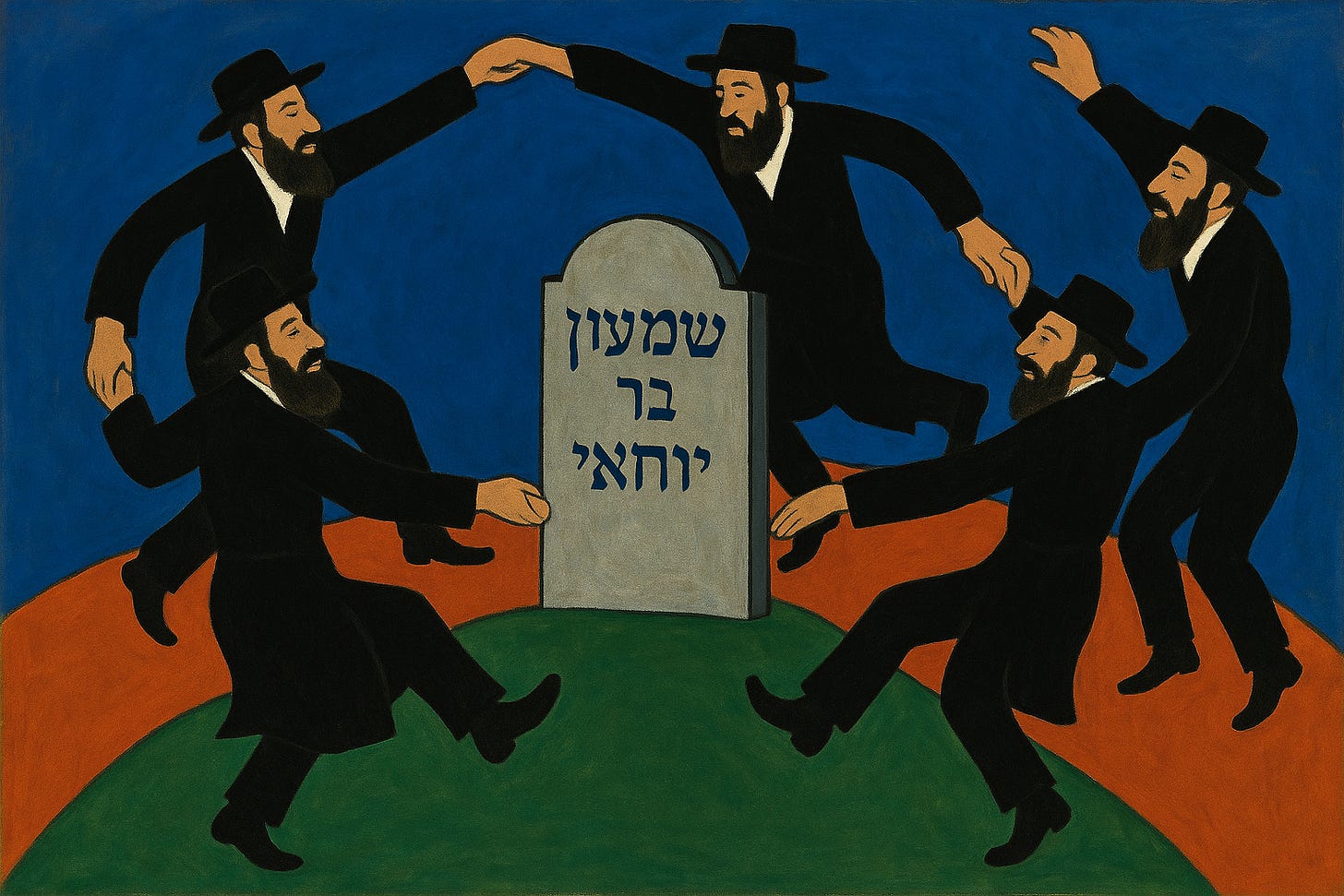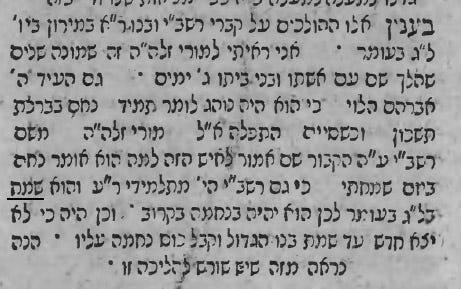Lag ba’Omer PSA: The Falsehood of Rabbi Shimon bar Yochai’s Yahrzeit
Mark Twain said, “Be careful about reading health books. You may die of a misprint.” Rumors of Rashbi’s death on Lag ba’Omer have been greatly exaggerated. They trace back to a misprint from 1802.
SPECIAL OFFER: I’m planning to write more on my Substack this summer than I have in the past few years, including a ton of paid subscriber posts I’ve been eager to publish. From now until Shavuos, for every week of content you sponsor, I’ll add a full month of paid subscription access. If you’re interested in sponsoring, let me know!
Click here for a printer-friendly version of this article.

This is a corrected and expanded version of this morning's WITATM post. I decided to issue it as a free article today because tomorrow, on Lag ba’Omer, I’m planning to post a paid subscriber article about the Zohar that’ll probably get me crucified, and I wanted to get this PSA out before I die.
UPDATE (as of 5/15/25 at 10:00pm): I’m not going to publish that Zohar post tomorrow. (a) I won’t be finished by then, (b) even if I finish, I want to let it sit, and (c) frankly, I’m not in the mood to deal with the backlash. It’ll have to wait for another time!
Lag ba’Omer PSA: The Falsehood of Rabbi Shimon bar Yochai’s Yahrzeit
I train my students to ask of any halacha they hear: Which category does it belong to? Is it de’Oraisa (Biblical), de’Rabbanan (Rabbinic), minhag (custom), or “bagels & lox” (popular among Jews, but not even a minhag)?
Aside from the mitzvah of counting the 33rd day, everything else associated with Lag ba’Omer is either minhag or bagels & lox. But Lag ba’Omer is like an onion—it has layers. Each year, I seem to peel back one more layer.
My most recent discovery shocked even me: the entire notion that Lag ba’Omer is the yahrzeit (death anniversary) of R' Shimon bar Yochai stems from a printing error in 1802. Before that, NOBODY believed Rashbi died on Lag ba'Omer.
I learned this from Mitchell First’s article The Mysterious Origin of Lag Ba-Omer (Ḥakirah, Vol. 20 pp. 205-217). First doesn’t even investigate the yahrzeit claim, because unlike the other customs and beliefs about the day, it’s neither ancient nor a mystery. It’s a modern mistake with a definite source.
In footnote 3, First cites an article by R' Eliezer Brodt: A Printing Mistake and the Mysterious Origins of Rashbi’s Yahrzeit (2011). R’ Brodt traces the origin of the mistake to a single printing error in R’ Chaim Vital’s Peri Etz Chaim. Here is the original 1782 printing, followed by the 1802 edition, which contains the error:
פרי עץ חיים (1782)
גם העיד ה[רב] אברהם הלוי כי הוא היה נוהג לומר תמיד נחם בברכת תשכון וכשסיים התפלה א"ל מורי זלה"ה משם רשב"י ע"ה הקבור שם אמור לאיש הזה למה הוא אומר נחם ביום שמחתי כי גם רשב"י היה מתלמידי ר"ע והוא שמח בל״ג בעומר לכן הוא יהיה בנחמה בקרוב. וכן היה כי לא יצא חדש עד שמת בנו הגדול וקבל כוס נחמה עליו. היה נראה מזה שיש שורש להלכה זו.Peri Etz Chaim (original printing, Koretz 1782)
R’ Avraham ha’Levi also testified that he used to regularly recite Nachem in the blessing of Tishkon (i.e. the berachah about Yerushalayim in the Amidah). When he finished praying, my teacher (of blessed memory) said to him on behalf of R’ Shimon bar Yochai (peace be upon him), who is buried there: “Say to this man: ‘Why does he recite Nachem on the day of my rejoicing?’ since Rashbi, too, was one of the students of R’ Akiva, and he REJOICED on Lag ba’Omer. Therefore, he will soon [experience] consolation (i.e. he will experience the death of a close relative, and need consolation).” And so it was: the month had not yet passed before his eldest son died, and he received the cup of consolation for him. From this, it appears that there is a basis for this halacha [of making a pilgrimage to Meron].פרי עץ חיים (1802)
גם העיד לי הר"א הלוי כי הוא היה נוהג לומר נחם בברכת תשכון וכשמסיים אחר התפלה אמר מורי ז"ל בשם ר' שמעון בן יוחאי הקבור שם שאמר לי אמור לאיש הזה למה הוא אומר נחם ביום שמחתי. לכן הוא יהיה בנחמה בזמן קרוב. וכן לא יצא חודש עד שמת בנו הגדול וקיבל כוס נחמה עליו. נראה מכל זה שיש שורש ליציאה זו והטעם שמת רשב"י ביום ל"ג בעומר כי הוא מתלמידי רבי עקיבא הנ"ל שמתו בספירת העומר הנ"ל.Peri Etz Chaim (second printing, Dubrowno 1802)
R' Avraham Ha’Levi also testified to me that he was accustomed to reciting Nachem in the blessing of Tishkon. After he finished praying, my teacher (of blessed memory) said to me in the name of R’ Shimon bar Yochai, who is buried there: “Say to this man: Why does he say Nachem on the day of my rejoicing? Therefore, he will receive consolation soon.” And indeed, the month had not passed before his eldest son died, and he received the cup of consolation for him. From all this, it appears that there is a basis for this pilgrimage [to Meron], and the reason is that R’ Shimon bar Yochai DIED on Lag ba'Omer, for he was one of the students of R’ Akiva mentioned above, who died during the Counting of the Omer, as mentioned above.
The 1802 edition swapped the ח in samach (שמח, “rejoiced”) for a ת, changing it to she’meis (שמת, “that he died”). As a result, the phrase “Rashbi … rejoiced on Lag ba’Omer” became “Rashbi died on Lag ba’Omer.”
If someone wanted to argue that the original edition contained the error and the second printing corrected it, that claim is refuted by the fact that both versions quote Rashbi referring to Lag ba’Omer as yom simchasi (יום שמחתי, “the day of my rejoicing”), which parallels the 1782 version’s explicit mention of Rashbi rejoicing on that day.
Moreover, the 1802 edition states, “R’ Shimon bar Yochai died on Lag ba'Omer, for he was one of the students of R’ Akiva mentioned above, who died during the Counting of the Omer.” This is false. While R’ Shimon bar Yochai was a student of R’ Akiva, he was not one of the 24,000 students who died between Pesach and Shavuos. On the contrary—Yevamos 62b, the primary source for the deaths of R’ Akiva’s students, names R’ Shimon bar Yochai as one of the second group of students who survived.
And if that isn’t compelling enough, R’ Brodt cites numerous authorities—including the Lubavitcher Rebbe!—who identified this printing mistake. More compelling to my mind are the many pre-1802 sources that describe pilgrimages to Rashbi’s grave on Lag ba’Omer but say NOTHING about a yahrzeit. This is a striking omission for a people that keeps such meticulous records of the yahrzeits of great rabbis.
Thus, it is clear that שמח is correct, as per the 1782 edition, and שמת in the 1802 printing is the typo.
I have mixed feelings about Lag ba’Omer as a whole, especially given the many deeply problematic practices I haven’t even touched on here. I can accept the day’s extreme accumulation of minhagim, but my tolerance has its limits. Celebrating Rashbi is one thing, but perpetuating a clear falsehood is another. Spread the word!
Let me know what you think!
Like what you read? Give this article a “like” and share it with someone who might appreciate it!
Want access to my paid content without actually paying? If you successfully refer enough friends, you can get access to the paid tier for free!
Interested in reading more? Become a free subscriber, or upgrade to a paid subscription for the upcoming exclusive content!
If you've gained from what you've learned here, please consider contributing to my Patreon at www.patreon.com/rabbischneeweiss. Alternatively, if you would like to make a direct contribution to the "Rabbi Schneeweiss Torah Content Fund," my Venmo is @Matt-Schneeweiss, and my Zelle and PayPal are mattschneeweiss at gmail. Even a small contribution goes a long way to covering the costs of my podcasts, and will provide me with the financial freedom to produce even more Torah content for you.
If you would like to sponsor a day's or a week's worth of content, or if you are interested in enlisting my services as a teacher or tutor. Thank you to my listeners for listening, thank you to my readers for reading, and thank you to my supporters for supporting my efforts to make Torah ideas available and accessible to everyone.
-----
Substack: rabbischneeweiss.substack.com/
Patreon: patreon.com/rabbischneeweiss
YouTube: youtube.com/rabbischneeweiss
Instagram: instagram.com/rabbischneeweiss/
"The Stoic Jew" Podcast: thestoicjew.buzzsprout.com
"Machshavah Lab" Podcast: machshavahlab.buzzsprout.com
"The Mishlei Podcast": mishlei.buzzsprout.com
"Rambam Bekius" Podcast: rambambekius.buzzsprout.com
"The Tefilah Podcast": tefilah.buzzsprout.com
Old Blog: kolhaseridim.blogspot.com/
WhatsApp Content Hub (where I post all my content and announce my public classes): https://chat.whatsapp.com/GEB1EPIAarsELfHWuI2k0H
Amazon Wishlist: amazon.com/hz/wishlist/ls/Y72CSP86S24W?ref_=wl_sharel






Usually "falsehood" is reserved for something intentional or malicious, not a printing error. In this case, I don't really understand the intolerance, it's not like this mistake makes a big difference. If anything the corrected printing makes a better case to celebrate Lag B'Omer! I think the intolerance in this case is similar to Shadal's selective intolerance of ungrammatical kabbalistic prayers, and stems from the Maskilim's intolerance of anything connected to kabbalah or the irrational.
Haven't looked into this all that much but I believe this (mis)conception long predates 1802 (will update if have time to research) and isn't necessarily based on this alleged printing error.
Zohar describes the day that Rashbi died as one full of joy, even referring to it as a הילולא-celebration, a term typically reserved for weddings.
That being the case perhaps the connection was easily made between Rashbi's unidentified day of joy with the day of his death.
Perhaps the alleged printing error was an outgrowth of this not unreasonable assumption.
Although see here https://www.yeshiva.org.il/wiki/index.php/%D7%9C%22%D7%92_%D7%91%D7%A2%D7%95%D7%9E%D7%A8 where Chida made this point already: אמנם, החיד"א כתב כי ככל הנראה מדובר בטעות סופר והוכיח זאת מכך שלמרות שרבי חיים ויטאל תלמיד האר"י כתב רבות על יום ל"ג בעומר כיום שמחתו של רשב"י שלמד באותו היום מרבי עקיבא, עדיין לא הזכיר את דברי רבו על כך שיום זה הוא יום פטירתו של רשב"י.
Apparently the day R Akiva taught Rashbi was also a joyous day so not so sure about my theory anymore . .